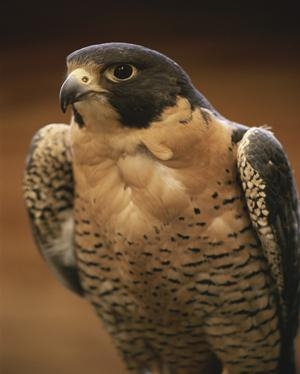Mon, Sep 10, 2012
These Fighting Falcons Are Not F-16s
The 22nd Air Refueling Wing Bird Aircraft Strike Hazard program is being overhauled with new contractors employing the use of a falcon to keep skies clear from avian adversaries. The BASH program is in place to reduce bird strikes by introducing a natural predator into the area to ward off smaller animals. McConnell Air Force Base in Kansas will be changing the type of predator used from a dog to a pair of falcons.

Elaina, a Barbary falcon, and Jack, a Peregrine-Prairie hybrid (similar bird pictured), will be McConnell's new solution, capable of providing smaller birds the motivation to move along. "One strike, if the bird hits the wrong spot on a plane, could do fifty to one hundred thousand dollars worth of damage," said Maj. Jeremy Fischman, 22nd ARW flight safety chief. "It is really easy for the program to pay for itself by preventing one bad bird strike."
Preventing bird strikes also maintains safety by not putting Airmen in a situation where they have to maneuver aircraft damaged in flight. There were 4,471 bird strikes Air Force-wide in 2011, costing the service $13,061,140.
While the fields and ponds surrounding McConnell are inviting habitats for birds, the falcons will be introduced as a predatory species. The birds instinctively know that it is too dangerous to seek food and shelter once they note the presence of the falcons. There are several other ways that bird and wildlife populations are humanely controlled around the airfield including fencing certain areas off, mowing the grass near the flight line to a prescribed height and draining puddles. Cannon blasts and noise makers can also be used to disperse unwanted flocks. "I'll be trapping or using depredation to manage problem mammals," said Elizabeth Hensel, Falcon Environmental Services, Inc. wildlife manager.
For example, if there is a red-tail hawk, Hensel can trap the bird and move it to another location 50 miles away leading to one less bird threatening the fleet. Having falcons will help disperse the birds and hopefully there will be less of a bird strike concern for the KC-135 Stratotankers, said Hensel.
(USAF Image)
ANN salutes Airman 1st Class Jose L. Leon 22nd Air Refueling Wing Public Affairs.
More News
Takeoff Roll The process whereby an aircraft is aligned with the runway centerline and the aircraft is moving with the intent to take off. For helicopters, this pertains to the act>[...]
“We’re proud of the hard work that went into receiving this validation, and it will be a welcome relief to our customers in the European Union. We couldn’t be mor>[...]
"Aircraft Spruce is pleased to announce the acquisition of the parts distribution operations of Wag-Aero. Wag-Aero was founded in the 1960’s by Dick and Bobbie Wagner in the >[...]
IDENT Feature The special feature in the Air Traffic Control Radar Beacon System (ATCRBS) equipment. It is used to immediately distinguish one displayed beacon target from other be>[...]
Aero Linx: Pararescue Air Force Pararescuemen, also known as PJs, are the only DoD elite combat forces specifically organized, trained, equipped, and postured to conduct full spect>[...]
 ANN's Daily Aero-Term (05.10.24): Takeoff Roll
ANN's Daily Aero-Term (05.10.24): Takeoff Roll Aero-News: Quote of the Day (05.10.24)
Aero-News: Quote of the Day (05.10.24) Aero-News: Quote of the Day (05.11.24)
Aero-News: Quote of the Day (05.11.24) ANN's Daily Aero-Term (05.11.24): IDENT Feature
ANN's Daily Aero-Term (05.11.24): IDENT Feature ANN's Daily Aero-Linx (05.11.24)
ANN's Daily Aero-Linx (05.11.24)



